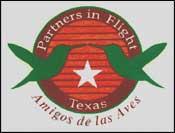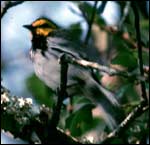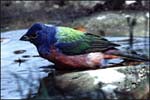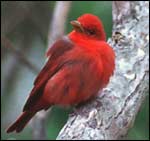Texas Partners in Flight
How Can You Assist Migratory Landbirds?
In Your Backyard and in Your Community
In Your Backyard

- Write to the Texas Wildlife Conservation team to find out how you can help locally.
- Provide food, cover, and water for birds; use native food plants. See bullet #1 under “In Your Community” for more information.
- Share with your neighbors what you are doing and why. Encourage them to join in.
- Make your cat a “house
cat” (keep it
indoors). Cats kill
native birds and other
animals. See bullet
#3 under “In Your
Community” for
more information.

Golden-cheeked Warbler
- Protect birds from large plate glass windows with a “hawk silhouette” or with protective screening.
- Some insect larvae specific to certain trees are eaten by birds. Investigate prior to using chemicals to exterminate them; you may be eradicating a valuable source of bird food.
- If you own large tracts of land, learn what management options are needed for migratory birds in your area.
- Protect and manage your back yard trees. Contact your local garden center to inquire about native trees and shrubs they may stock as well as their care. Native trees and understory can provide cover, protection, and food in certain regions.

Painted Bunting
Be Sure to . . .
- Make a donation to the
Nongame Fund at Texas Parks
and Wildlife.
Please write to: Wildlife Conservation Branch, 4200 Smith School Rd., Austin, TX 78744. - Whenever possible, encourage local, state, and federal officials to support legislation designed to protect wildlife habitat. Write and call them…the birds need your support!

Scarlet Tanager
In Your Community
- Encourage your neighbors to plant native vegetation for neotropical birds and other wildlife in connecting corridors. Do a demonstration hummingbird garden in your local city parks. For more information, see Texas wildscapes.
- Make a bird checklist for your town or community. Share this with local science teachers, birdwatching clubs, city planners, and social groups. Assist teachers to design bird conservation projects for kids such as constructing bird feeders.
- Encourage your town to develop a plan to protect birds. Help your community develop a plan for controlling feral cats. For more information, see
- Encourage your county and local parks and recreation department to work with Texas Parks and Wildlife to develop a wildlife plan to benefit non-game birds.
- Promote awareness of habitat issues outside your community, including the role of Latin American countries. Simple things like buying shade-grown coffee can make a difference.
- Emphasize that birds, bats, butterflies, and the air we breathe all connect us with neighboring countries.
- Nominate your community birding “hot spots” to the Birding Trail. Check out Greater Texas Wildlife Trails.
For
additional information
write to:
Wildlife Conservation Program
Texas Parks and Wildlife Department
4200 Smith School Road
Austin, TX 78744
or send a message to: nature@tpwd.texas.gov